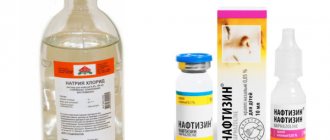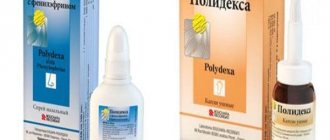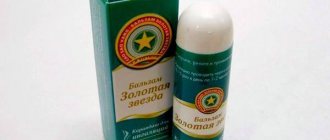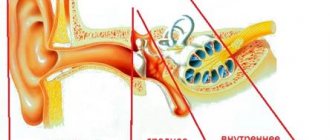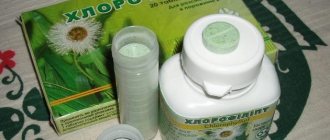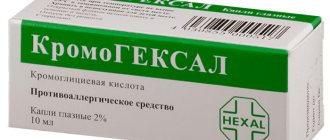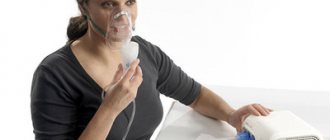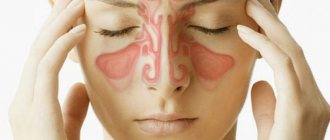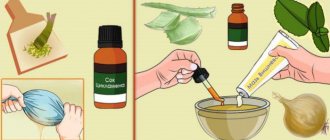Vasoconstrictor nasal drops - pros and cons of use
The mucous membrane of the nasal cavity becomes inflamed when:
- hypothermia;
- infection with viruses of various diseases and bacteria;
- action of irritants.
Due to the influence of these factors, a runny nose, or rhinorrhea, begins, which is manifested by copious secretion of mucus from the nasal passages. Rhinitis is also accompanied by sneezing and decreased sense of smell.
Benefits of treating a runny nose with nasal drops
Drugs that constrict blood vessels make it easier to endure the acute period of acute respiratory viral infections, influenza, and allergies. The active substance in the nasal product most often belongs to the group of anticongestants. They provoke a narrowing of the lumen and a decrease in the permeability of the vessels lining the inflamed mucous membrane. As a result, swelling decreases and mucus production decreases.
The vasoconstrictor effect of the drug develops after a few minutes and lasts from 30 minutes to several hours.
Pharmacies have a large selection of products used topically for a runny nose. The drugs are available in the form of drops or spray.
- The first get on the mucous membrane when squeezing a plastic bottle or just a soft nozzle on the neck of a glass bottle.
- The spray is sprayed using a mini pump.
The advantage of the drip method is the ability to use the drug in the treatment of runny nose in infants. The spray can be used no earlier than 2 years. The liquid medicine settles “in place” and does not cause bronchospasm. Nasal medications with a “children's” dosage are intended for the treatment of a small child.
Disadvantages of use
Vasoconstrictor drugs only temporarily relieve a runny nose and do not treat the underlying disease. Drugs in this group develop addiction, so it is recommended to use them for 3 to 7 days. On the first day, you can instill the maximum number of times allowed (according to the instructions). Then you need to reduce the dosage.
To reduce side effects, antihistamines are used simultaneously. The causative disease is treated with antiviral and antibacterial drugs.
If you use a nasal vasoconstrictor frequently:
- swelling of the mucous membranes increases;
- it dries up;
- becomes easily irritated;
- Often unpleasant consequences appear: medicinal and atrophic rhinitis.
Also, anticongestants in the drops can increase blood pressure and cause increased excitability.
Folk vasoconstrictors for the nose
Nasal congestion (runny nose) can be caused by various factors. So, often the occurrence of edema is caused by allergies to dust, household chemicals, medicines, and animal hair. In addition, rhinitis accompanies the course of many respiratory diseases - from the common cold, flu to pneumonia.
Swelling of the nasal mucosa can be caused by various formations (tumors, polyps), as well as mechanical damage resulting from injuries or foreign objects entering the nasal passages.
The list of other congestion provocateurs includes the following factors:
- problems with cerebral vessels;
- deviated nasal septum;
- congenital or acquired narrowing of the nasal passages;
- frequent drinking of alcohol, smoking;
- unfavorable environmental situation in the region of residence.
How to deal with the problem
People who suffer from chronic runny nose of various origins are in constant search of a remedy that could alleviate their condition, relieve swelling and restore “healthy” breathing. It happens that sudden congestion goes away on its own, disappearing as imperceptibly as it appeared. But in most cases, swelling continues to haunt the “victim” for a week or longer.
Many patients, not wanting to go to the doctor and determine the cause of the runny nose, purchase various vasoconstrictor drops from pharmacies. It is necessary to understand that such local remedies demonstrate a short-term symptomatic effect (relieve swelling, facilitate breathing) and are only auxiliary drugs in the complex treatment of respiratory diseases.
They are used in courses (no longer than 7 days) on the recommendation of a specialist.
If you drip vasoconstrictors into your nose for a long time, you can develop medicinal or vasomotor rhinitis - these drugs, when overdosed, cause abnormal growth of the nasal mucosa.
Moreover, against allergic rhinitis or those caused by injuries, tumors and other non-infectious factors, these drugs are powerless.
Traditional methods
The question arises: how to relieve nasal congestion without vasoconstrictor drops? Treatment depends on the cause of swelling: polyps, tumors are removed surgically, allergic rhinitis is eliminated by taking systemic and local antihistamines; if a patient with a stuffy nose lives in a region with polluted air, the only salvation for him is regular rinsing of the nose (for example, with saline solutions) .
Long-term use of vasoconstrictor drops leads to drug-induced or vasomotor rhinitis
Important! We relieve swelling with “distraction” therapy without vasoconstrictor drops.
This treatment helps ease breathing by stimulating blood circulation in the vessels. The list of “distraction” therapeutic activities includes:
- hot foot baths (procedure lasts 15–20 minutes);
- warming compresses;
- banks;
- hot, plentiful drink;
- mustard plasters on the feet.
In addition, natural (homeopathic) pharmaceutical drops - for example, Pinosol - are good helpers in the fight against congestion. Such drugs can be used long-term, they are suitable for the symptomatic treatment of vasomotor and allergic rhinitis.
You can prepare decongestant drops yourself at home. The best raw material for such a medicine is Kalanchoe leaves. The juice of this medicinal plant has antibacterial, anti-inflammatory properties and has a positive effect on the nasal mucosa. Directions for use: 2-3 drops are administered into each nostril 3-4 times a day.
Massage is another effective method of combating congestion of various etiologies. So, to relieve swelling, you need to gently press on the active point located between the nose and upper lip for 3-5 minutes, then massage the area of the bridge of the nose and wings of the nose.
Important! To enhance the therapeutic effect, before the massage, you can apply a small amount of Vietnamese “Star” balm to your fingers. Thanks to its warming, irritating properties, this remedy will additionally increase blood circulation and help cope with swelling. It is necessary to ensure that the balm does not get on the nasal mucosa - a burn may occur.
Map of massage points to relieve nasal swelling
Washing is an effective procedure aimed at removing accumulated mucus and pathogenic bacteria from the nasal passages (it is they that provoke the development of the inflammatory process and cause congestion in respiratory diseases). In addition, rinsing solutions moisturize the mucous membrane well, which is important in a situation where a runny nose is caused by increased dry air.
How to wash a swollen nose:
- warm boiled water;
- saline-soda solution (½ of both powders per glass of water);
- pharmaceutical compositions based on sea water (Aqua Maris, Aqualor, Marimer) or saline;
- infusions of medicinal herbs (they are prepared from eucalyptus leaves, chamomile flowers, calendula, St. John's wort, calendula).
If you have a runny nose without purulent discharge, it is good to warm it up. The easiest way is to apply a bag of warm salt to the bridge of your nose (it can be replaced with regular sand). Warming is not carried out at elevated body temperatures. You can rinse your nose at home with warm water or saline using a regular kettle.
Inhalation is another useful procedure that cannot be avoided in the complex fight against rhinitis of any nature. It is carried out using a nebulizer (pharmacy inhaler that sprays medicinal compounds) or by breathing healing steam.
The choice of nebulizer solutions should be entrusted to specialists (pharmacies sell antibacterial, anti-inflammatory, moisturizing, antimicrobial drugs). The leaders among the compositions intended for steam inhalation are decoctions and infusions of medicinal herbs and essential oils. You can also breathe over hot potatoes boiled in their skins.
There are also so-called dry inhalations - usually for such procedures you chop onions or garlic, cover your head with a towel and inhale medicinal vapors for 5-7 minutes.
Pharmacy drops with hormonal components cope with severe swelling in allergic rhinitis
Systemic pharmaceutical anti-cold medications help in the fight against a runny nose. These include, for example, Maxicold. It facilitates general well-being, relieves swelling, facilitates breathing, reduces temperature, and strengthens the immune system. Maxicold dosage regimen: 2 tablets/4 times a day, an hour before or an hour after meals.
Traditional methods
Let's consider several useful recipes that can be used in a comprehensive fight against nasal congestion:
- Infusion of oak bark (1 tsp / glass of boiling water). How to use: drop warm into the nose in the morning and evening (2-3 drops/nostril).
- Combine crushed roots of elecampane, marshmallow, and licorice in equal parts, add 500 ml of cold water, leave for 8 hours, take ½ cup three times a day.
- Four teaspoons of onion juice are mixed with 50 ml of warm water, a little honey is added, and left for half an hour. Place the composition in the nose three times a day (2 drops per nostril).
Prevention
To avoid swelling of the nasal mucosa, it is recommended to follow a few simple rules:
- avoid contact with those who have ARVI symptoms;
- do not overcool;
- avoid overly spicy, salty, spicy foods;
- fight bad habits;
- take vitamin and mineral complexes several times a year to maintain immunity;
- promptly clean living and working areas, humidify the air, and try to avoid allergens;
- drink up to 2.5 liters of liquid per day;
- practice regular moderate physical activity.
Nasal congestion is a pathological phenomenon that can be caused by various factors: only by accurately establishing the cause of the runny nose can the correct treatment be selected.
https://www.youtube.com/watch?v=VB73KiQKL0s
There are several ways to eliminate nasal edema without vasoconstrictor drops - inhalation, heating, nasal rinsing, massage. It is important to understand that these are only symptomatic measures that do not get rid of the root cause of the problems. For prolonged chronic rhinitis, you should seek help from a doctor.
Source: https://prostuda.feedjc.org/sosudosuzhivajushhie-sredstva-dlja-nosa-narodnye/
Indications for use of drops
Too active fighting a runny nose brings harm, not good. Of course, the watery secretion interferes with breathing and speaking normally. However, a runny nose is the body’s way of fighting infection and allergens. An increase in blood supply to the nasal mucosa and abundant mucus secretion are necessary to cleanse the nasal passages and destroy germs and their toxins.
Strong anticongestants for topical use (oxymetazoline, xylometazoline, naphazoline) when applied to the mucous membrane, reduce local redness, swelling and inflammation, and facilitate nasal breathing.
Indications for the use of drops that constrict blood vessels in the nose:
- acute infectious or allergic rhinitis;
- chronic diseases of the nose and nasopharynx;
- rhinoscopy and similar procedures;
- sinusitis in acute and chronic forms;
- nosebleeds;
- otitis media;
- eustachitis;
- hay fever
The vasoconstrictor effect of sea water and saline in nasal drops is less pronounced.
Such means are used:
- to reduce dry nose;
- when inhaling polluted air;
- for the prevention of ARVI and complications of the common cold (otitis media, sinusitis).
After instillation or rinsing of the nasal passages with a preparation based on saline solutions, nasal medications “Vibrocil”, “Flixonase”, “Tizin Alergy” or others are used.
List of vasoconstrictor drugs for the nose
For acute respiratory viral infections, colds or prolonged inflammation in the nasal cavity, it is better to use Derinat solution (an immunomodulatory agent) for instillation. If greenish-yellow or brownish mucus is released from the nasal passages, then, in addition to vasoconstrictor drops, Isofra spray with an antibiotic is prescribed.
Short acting
The effect of respiratory agents develops 2-15 minutes after application to the nasal mucosa. The drugs differ not only in the period before the onset of the vasoconstrictor effect, but also in its duration. The most popular drops for a runny nose help relieve swelling quickly and permanently.
- "Vibrocil" and "Adrianol". These are combined respiratory drugs. Phenylephrine in their composition has a vasoconstrictor effect 2 minutes after application to the mucous membrane. The effect lasts for 8 hours. The second component in the drug "Vibrocil" is an antiallergic medicine. Lerimazoline in Adrianol drops is a vasoconstrictor and decongestant.
- "Naphazoline". After applying the product with naphazoline, the vasoconstrictor effect develops within a few minutes. The effect lasts from 2 to 8 hours.
List of drugs (price in rubles):
- "Sanorin" (from 130 to 170);
- "Naphthyzin" (from 7 to 24);
- "Naphthyzin Plus" (from 25).
When solutions are used topically, the active substance enters the systemic circulation. The vasoconstrictor effect decreases after 5–7 days of treatment.
Medium duration
Tramazolin in nasal drops or spray reduces congestion and swelling of the mucous membrane during allergic rhinitis and colds. The action begins 5 minutes after application and lasts from 8 to 10 hours. The name of the drug is “Lazolvan Rino”. In combination with phenylephrine, it is contained in Adrianol nasal drops.
- "Tizin Alergy" is a nasal spray with levocabastine. Local antiallergic and vasoconstrictive effect occurs 5 minutes after application. The action lasts for 12 hours. The spray eliminates sneezing and reduces nasal discharge.
- "Pinosol." The vasoconstrictor drug of plant origin is available in the form of oily nasal drops, spray and ointment (price 140, 240 and 270 rubles, respectively). A product based on essential oils is used for runny nose of various origins and duration. Almost non-addictive.
- "Nazaval Plus". This cellulose powder forms a protective film on the nasal mucosa. It protects against exposure to allergens and microbes, so vasoconstrictor drops are required less often.
- Xylometazoline. This active ingredient is contained in a large number of nasal drops and sprays. More than 35 drugs with various trade names are produced based on xylometazoline. For the treatment of adults, products containing 0.1% active substance are suitable.
The dosage of xylometazoline for adults is 2-3 drops in each nasal passage, no more than 3 times a day. The product begins to act in 3–7 minutes. The vasoconstrictor effect lasts from 2 to 10 hours (depending on the disease).
List of vasoconstrictor drops and sprays (price in rubles):
- "Tizin Xylo" (from 97 to 194).
- “Star Noz” (from 35 to 75).
- "Xymelin" (from 70 to 178).
- "Otrivin" (from 150 to 176).
- "Xymelin Eco" (160).
- "Galazolin" (from 35).
- "Rinostop" (from 25).
- "Rinonorm" (from 70).
- "Rinorus" (up to 62).
- "Snoop" (130).
Long-term exposure
Adults can use topical remedies with oxymetazoline 0.05% to treat a runny nose and ease breathing. The effect of the medicine begins 15 minutes after application to the mucous membrane and lasts from 6 to 8 hours.
List of nasal drops/sprays with oxymetazoline (price in rubles):
- "Sialor rhino" (110).
- "Nesopin" (from 90).
- "Afrin" (from 180).
- "Nazol" (from 150).
- "Nazivin" (150).
Oxymetazoline increases vascular tone, resulting in reduced swelling and reduced mucus secretion. The effects are greater when taking antihistamines simultaneously (Cetirizine, Loratadine, Desloratadine).
Therapeutic nasal drops for patients with hypertension and glaucoma
Depending on the effect of drops on the causes of a runny nose, they are divided into the following types:
- Antihistamine drops
- Moisturizers;
- Plant-based drops.
Some drugs in these groups contain vasoconstrictor components to provide the most pronounced effect. It is these exceptional drops for a runny nose with glaucoma and hypertension that are prohibited.
Antihistamines for glaucoma and hypertension include Allergodil, Histimet, and Reactin. Complex drops based on anthistamines and decongestants (Vibprocil, Sanorin Analergin, Tizin Allergy) cannot be taken by patients with these diseases, because they also contain vasoconstrictor components.
Also among antiallergic drugs, hypertensive patients and patients with glaucoma can use
- Nazaval and Nazaval Plus;
- The hormonal drops described above;
- Cromohexal, Cromoglin, Cromosol, Ifiral.
The most popular products on the domestic pharmaceutical market that moisturize the nasal mucosa, Physiomer, Aqua Maris, Aqualor and Salin, do not have side effects and can be widely used for various somatic pathologies, including hypertension. They help maintain the normal condition of the nasal mucosa and promote rapid recovery.
Aqualor spray has virtually no contraindications and can be used for glaucoma
Similarly, oil drops for a runny nose can be used for diseases associated with high blood pressure.
Herbal remedies do not affect blood pressure levels and can be included in a set of measures aimed at combating rhinitis in patients with hypertension. Drugs in this group include Valogep, Glycyrfit, Pinosol, Eucasept - all of them are safe for hypertension and glaucoma.
And remember: even drops for the common cold that are safe for high blood pressure have their contraindications and side effects. They can cause allergies, lead to disruption of the epithelium in the nose, and disrupt the pharmacokinetics of other drugs. Therefore, you cannot prescribe even such remedies to yourself. This should only be done by a good and responsible ENT specialist.
What vasoconstrictor drops can pregnant women use?
Not all medications are approved for use during pregnancy. The therapeutic agents used must not harm the mother or the unborn child. Let's find out which vasoconstrictor drops are suitable for pregnant women.
Drops and sprays based on saline solutions have a mild, gentle effect:
- "Aqua Master";
- "Aqualor";
- "Marimer";
- "Aquamaris".
They do not have a strong effect and do not relieve a runny nose instantly.
Drops and sprays with oxymetazoline are conditionally allowed during pregnancy:
- "Otrivin";
- "Nazivin";
- "Nesolin";
- "Nazol."
Vasoconstrictor drops and sprays are prescribed to pregnant women only in cases where the expected benefit justifies the potential risk to the fetus.
You can take the plant-based remedy “Sinupret” orally, which thins viscous mucus. After consultation with the doctor, chronic runny nose is treated with drops of corticosteroid substances: Flixazone, Nazarel.
The most budget drugs
Even a brief overview of the prices for drops and sprays with the same active ingredient convinces that the cost is influenced by the release form and advertising costs. The main criteria for choosing a medicine: indications, contraindications and the presence of serious side effects. In case of difficulties, you should contact your doctor or pharmacist at the pharmacy.
Among the naphazoline preparations there are inexpensive vasoconstrictor drops and Naphthyzin spray (from 7 to 25 rubles).
Preparations based on xylometazoline are considered budget-friendly:
- "Rinostop";
- "Xymelin";
- "Rinonorm";
- "Rinorus".
The cost of funds is in the range of 25–70 rubles. The effect of these vasoconstrictor drops develops quickly and, if well tolerated, after half an hour you can forget about a runny nose for at least 2 hours.
Contraindications and side effects
Most nasal preparations based on saline and sea water are intended for patients starting from infancy. A ban on the use of such products is intolerance to the components.
But anticongestants in the composition of vasoconstrictor drops have the following contraindications:
- hypersensitivity to substances in the composition;
- atrophic and medicinal rhinitis;
- pregnancy (not for all drugs);
- increased intraocular pressure;
- severe atherosclerosis;
- arterial hypertension;
- diabetes;
- hyperthyroidism;
- tachycardia;
- glaucoma.
With frequent and/or prolonged use, side effects occur. The most common of them are: burning of the mucous membranes, sneezing, increased runny nose, headache and insomnia. Less commonly observed are Quincke's edema, heart rhythm disturbances and blurred vision.
Before using any vasoconstrictor drug, it is recommended to read the manufacturer's instructions. Although local forms of drugs do not affect internal organs, dosages and frequency of use must be observed. Drops or spray should not be used for longer than 8 days as they are addictive. To increase the effectiveness of treatment, it is recommended to first use a product with sea water to rinse the nasal cavity.
Folk remedies
Without pills, you can cope with high blood pressure using folk remedies. For hypertensive patients, it is advisable to replace regular green or black tea with herbal tea. For this purpose, chamomile flowers, peppermint, valerian, motherwort, rose hips, fennel, calendula, strawberries, oregano, St. John's wort, hawthorn, and dill in seeds are used.
To prepare healing tea, you need to take a dry mixture of several herbs (2 tbsp) and pour boiling water (500 ml). Infuse the tea for 8-10 hours, strain, and use as tea leaves. Pour 2-3 tsp. concentrated infusion with hot water and drink like regular tea after each meal.
In case of a sharp jump in blood pressure, it is recommended to drink the herbal infusion in pure undiluted form in a dosage of 2 tbsp. To relieve attacks of hypertension, you can use garlic tincture: chop 25 cloves of garlic, pour in 500 ml of vodka, place in a cool, dark place, leave for 14 days. Strain and take as an antihypertensive agent in a dosage of 1 tsp. 3 times a day after meals.
Monotherapy with traditional methods is not recommended, only in combination with basic drug treatment. Otherwise, there is a risk of deterioration in health and transition of hypertension from one stage to another.
Which medications or traditional methods to use for hypertension is decided exclusively by a cardiologist. No-shpu and theobromine are used to relieve attacks of arterial hypertension. In order to improve cerebral circulation, myotropic antispasmodics are prescribed. Combination therapy for hypertension should include: diuretics, calcium channel blockers, ACE inhibitors, adrenergic blockers.
